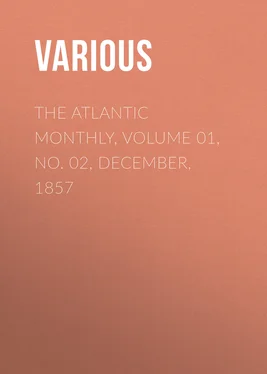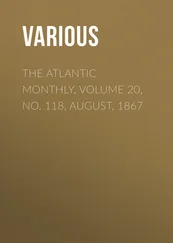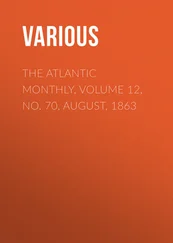Various - The Atlantic Monthly, Volume 01, No. 02, December, 1857
Здесь есть возможность читать онлайн «Various - The Atlantic Monthly, Volume 01, No. 02, December, 1857» — ознакомительный отрывок электронной книги совершенно бесплатно, а после прочтения отрывка купить полную версию. В некоторых случаях можно слушать аудио, скачать через торрент в формате fb2 и присутствует краткое содержание. Жанр: foreign_antique, periodic, foreign_edu, на английском языке. Описание произведения, (предисловие) а так же отзывы посетителей доступны на портале библиотеки ЛибКат.
- Название:The Atlantic Monthly, Volume 01, No. 02, December, 1857
- Автор:
- Жанр:
- Год:неизвестен
- ISBN:нет данных
- Рейтинг книги:3 / 5. Голосов: 1
-
Избранное:Добавить в избранное
- Отзывы:
-
Ваша оценка:
- 60
- 1
- 2
- 3
- 4
- 5
The Atlantic Monthly, Volume 01, No. 02, December, 1857: краткое содержание, описание и аннотация
Предлагаем к чтению аннотацию, описание, краткое содержание или предисловие (зависит от того, что написал сам автор книги «The Atlantic Monthly, Volume 01, No. 02, December, 1857»). Если вы не нашли необходимую информацию о книге — напишите в комментариях, мы постараемся отыскать её.
The Atlantic Monthly, Volume 01, No. 02, December, 1857 — читать онлайн ознакомительный отрывок
Ниже представлен текст книги, разбитый по страницам. Система сохранения места последней прочитанной страницы, позволяет с удобством читать онлайн бесплатно книгу «The Atlantic Monthly, Volume 01, No. 02, December, 1857», без необходимости каждый раз заново искать на чём Вы остановились. Поставьте закладку, и сможете в любой момент перейти на страницу, на которой закончили чтение.
Интервал:
Закладка:
Various
The Atlantic Monthly, Volume 01, No. 02, December, 1857 / A Magazine of Literature, Art, and Politics
FLORENTINE MOSAICS
VI. THE CARMINE
The only part of this ancient church which escaped destruction by fire in 1771 was, most fortunately, the famous Brancacci chapel. Here are the frescos by Masolino da Panicale, who died in the early part of the fifteenth century,—the Preaching of Saint Peter, and the Healing of the Sick. His scholar, Masaccio, (1402-1443,) continued the series, the completion of which was entrusted to Filippino Lippi, son of Fra Filippo.
No one can doubt that the hearty determination evinced by Masolino and Masaccio to deal with actual life, to grapple to their souls the visible forms of humanity, and to reproduce the types afterwards in new, vivid, breathing combinations of dignity and intelligent action, must have had an immense effect upon the course of Art. To judge by the few and somewhat injured specimens of these masters which are accessible, it is obvious that they had much more to do in forming the great schools of the fifteenth and sixteenth centuries, than a painter of such delicate, but limited genius as that of Fra Angelico could possibly have. Certainly, the courage and accuracy exhibited in the nude forms of Adam and Eve expelled from paradise, and the expressive grace in the group of Saint Paul conversing with Saint Peter in prison, where so much knowledge and power of action are combined with so much beauty, all show an immense advance over the best works of the preceding three quarters of a century.
Besides the great intrinsic merits of these paintings, the Brancacci chapel is especially interesting from the direct and unquestionable effect which it is known to have had upon younger painters. Here Raphael and Michel Angelo, in their youth, and Benvenuto Cellini passed many hours, copying and recopying what were then the first masterpieces of painting, the traces of which study are distinctly visible in their later productions; and here, too, according to Cellini, the famous punch in the nose befell Buonarotti, by which his well-known physiognomy acquired its marked peculiarity. Torregiani, painter and sculptor of secondary importance, but a bully of the first class,—a man who was in the habit of knocking about the artists whom he could not equal, and of breaking both their models and their heads,—had been accustomed to copy in the Brancacci chapel, among the rest. He had been much annoyed, according to his own account, by Michel Angelo's habit of laughing at the efforts of artists inferior in skill to himself, and had determined to punish him. One day, Buonarotti came into the chapel as usual, and whistled and sneered at a copy which Torregiani was making. The aggrieved artist, a man of large proportions, very truculent of aspect, with a loud voice and a savage frown, sprang upon his critic, and dealt him such a blow upon the nose, that the bone and cartilage yielded under his hand, according to his own account, as if they had been made of dough,— "come se fosse stato un cialdone." This was when both were very young men; but Torregiani, when relating the story many years afterwards, always congratulated himself that Buonarotti would bear the mark of the blow all his life. It may be added, that the bully met a hard fate afterwards. Having executed a statue in Spain for a grandee, he was very much outraged by receiving only thirty scudi as his reward, and accordingly smashed the statue to pieces with a sledge-hammer. In revenge, the Spaniard accused him of heresy, so that the unlucky artist was condemned to the flames by the Inquisition, and only escaped that horrible death by starving himself in prison before the execution.
VII. SANTA TRINITÀ
In the chapel of the Sassetti, in this church, is a good set of frescos by Dominic Ghirlandaio, representing passages from the life of Saint Francis. They are not so masterly as his compositions in the Santa Maria Novella. Moreover, they are badly placed, badly lighted, and badly injured. They are in a northwestern corner, where light never comes that comes to all. The dramatic power and Flemish skill in portraiture of the man are, however, very visible, even in the darkness. No painter of his century approached him in animated grouping and powerful physiognomizing. Dignified, noble, powerful, and natural, he is the exact counterpart of Fra Angelico, among the Quattrocentisti . Two great, distinct systems,—the shallow, shrinking, timid, but rapturously devotional, piously sentimental school, of which Beato Angelico was facile princeps , painfully adventuring out of the close atmosphere of the miniatori into the broader light and more gairish colors of the actual, and falling back, hesitating and distrustful; and the hardy, healthy, audacious naturalists, wreaking strong and warm human emotions upon vigorous expression and confident attitude;—these two widely separated streams of Art, remote from each other in origin, and fed by various rills, in their course through the century, were to meet in one ocean at its close. This was then the fulness of perfection, the age of Angelo and Raphael, Leonardo and Correggio.
VIII. SAN MARCO
Fra Beato Angelico, who was a brother of this Dominican house, has filled nearly the whole monastery with the works of his hand. Considering the date of his birth, 1387, and his conventual life, he was hardly less wonderful than his wonderful epoch. Here is the same convent, the same city; while instead merely of the works of Cimabue, Giotto, and Orgagna, there are masterpieces by all the painters who ever lived to study;—yet imagine the snuffy old monk who will show you about the edifice, or any of his brethren, coming out with a series of masterpieces! One might as well expect a new Savonarola, who was likewise a friar in this establishment, to preach against Pio Nono, and to get himself burned in the Piazza for his pains.
In the old chapter-house is a very large, and for the angelic Frater a very hazardous performance,—a Crucifixion. The heads here are full of feeling and feebleness, except those of Mary Mother and Mary Magdalen, which are both very touching and tender. There is, however, an absolute impotence to reproduce the actual, to deal with groups of humanity upon a liberal scale. There is his usual want of discrimination, too, in physiognomy; for if the seraphic and intellectual head of the penitent thief were transferred to the shoulders of the Saviour in exchange for his own, no one could dispute that it would be an improvement.
Up stairs is a very sweet Annunciation. The subdued, demure, somewhat astonished joy of the Virgin is poetically rendered, both in face and attitude, and the figure of the angel has much grace. A small, but beautiful composition, the Coronation of the Virgin, is perhaps the most impressive of the whole series.
Below is a series of frescos by a very second-rate artist, Poccetti. Among them is a portrait of Savonarola; but as the reformer was burned half a century before Poccetti was born, it has not even the merit of authenticity. It was from this house that Savonarola was taken to be imprisoned and executed in 1498. There seems something unsatisfactory about Savonarola. One naturally sympathizes with the bold denouncer of Alexander VI.; but there was a lack of benevolence in his head and his heart. Without that anterior depression of the sinciput, he could hardly have permitted two friends to walk into the fire in his stead, as they were about to do in the stupendous and horrible farce enacted in the Piazza Gran Duca. There was no lack of self-esteem either in the man or his head. Without it, he would scarcely have thought so highly of his rather washy scheme for reorganizing the democratic government, and so very humbly of the genius of Dante, Petrarch, and others, whose works he condemned to the flames. A fraternal regard, too, for such great artists as Fra Angelico and Fra Bartolommeo,—both members of his own convent, and the latter a personal friend,—might have prevented his organizing that famous holocaust of paintings, that wretched iconoclasm, by which he signalized his brief period of popularity and power. In weighing, gauging, and measuring such a man, one ought to remember, that if he could have had his way and carried out all his schemes, he would have abolished Borgianism certainly, and perhaps the papacy, but that he would have substituted the rhapsodical reign of a single demagogue, perpetually seeing visions and dreaming dreams for the direction of his fellow-citizens, who were all to be governed by the hallucinations of this puritan Mahomet.
Читать дальшеИнтервал:
Закладка:
Похожие книги на «The Atlantic Monthly, Volume 01, No. 02, December, 1857»
Представляем Вашему вниманию похожие книги на «The Atlantic Monthly, Volume 01, No. 02, December, 1857» списком для выбора. Мы отобрали схожую по названию и смыслу литературу в надежде предоставить читателям больше вариантов отыскать новые, интересные, ещё непрочитанные произведения.
Обсуждение, отзывы о книге «The Atlantic Monthly, Volume 01, No. 02, December, 1857» и просто собственные мнения читателей. Оставьте ваши комментарии, напишите, что Вы думаете о произведении, его смысле или главных героях. Укажите что конкретно понравилось, а что нет, и почему Вы так считаете.












